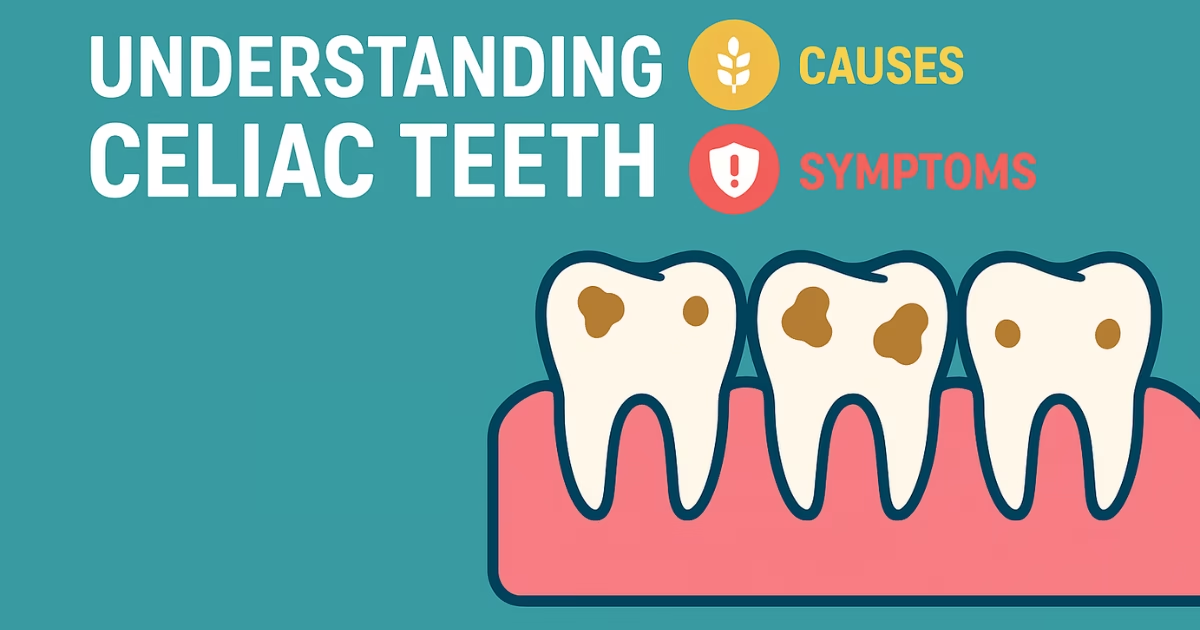Celiac disease is a chronic autoimmune condition that mainly affects the digestive system. However, many people don’t realize it can also impact other areas of the body, including dental health. One lesser-known effect is something called celiac teeth. This term refers to a range of dental issues that are linked to celiac disease, especially enamel defects and other oral health problems. These dental signs can sometimes even be an early clue that someone has undiagnosed celiac disease. Understanding how celiac disease can affect teeth is important for both patients and dentists. Poor enamel, discolored teeth, and a higher risk of cavities are common symptoms. For people living with celiac disease, knowing about these risks can help in taking better care of their teeth and catching problems early. In this article, we will explore everything you need to know about celiac teeth
What Are Celiac Teeth?
Celiac teeth refer to dental problems that are directly linked to celiac disease, an autoimmune disorder triggered by eating gluten. When someone with celiac disease consumes gluten, their immune system attacks the lining of the small intestine. But this reaction doesn’t just stay in the gut—it can also affect the development and health of teeth.
The main issue seen with celiac teeth is enamel defects. Enamel is the hard outer layer of the tooth, and in people with celiac disease, it can form poorly. This leads to teeth that have pits, grooves, or unusual colors like white, yellow, or brown spots. These defects usually appear on the permanent teeth and are most noticeable on the front teeth and molars.
Celiac teeth can affect both children and adults, though the damage often starts early in life. Understanding what celiac teeth are is the first step in recognizing the signs and seeking proper treatment.
Causes of Celiac Teeth
The main cause of celiac teeth is the body’s autoimmune reaction to gluten. In celiac disease, the immune system mistakenly attacks healthy tissue when gluten is present. While the small intestine is the main target, developing teeth can also be affected. This usually happens in early childhood when permanent teeth are forming.
Poor absorption of essential nutrients, like calcium and vitamin D, also plays a part. These nutrients are vital for strong enamel. If a child has undiagnosed celiac disease, their teeth might develop with thin enamel or other flaws. Even if the person follows a gluten-free diet later, the damage that happened during tooth formation cannot be reversed.
Genetics may also contribute. Some people are more prone to enamel defects due to both their genes and celiac disease. Overall, the combination of immune reactions and nutrient deficiencies explains why celiac teeth occur.
Common Symptoms of Celiac Teeth
The signs of celiac teeth are usually easy to spot once you know what to look for. One of the biggest clues is enamel hypoplasia, which means the enamel did not form properly. This can show up as pits, grooves, or thin spots on the teeth.
Another common symptom is tooth discoloration. Teeth may have white, yellow, or brown spots that don’t look normal. These color changes are not from staining but from weak enamel.
People with celiac teeth might also notice their teeth feel weak or chip easily. Cavities can happen more often because the enamel isn’t strong enough to protect the teeth. Other oral symptoms, like frequent mouth ulcers, inflamed gums, or a dry mouth, may also be present.
Together, these symptoms often lead dentists to ask if a patient has celiac disease or has been tested for it.
Diagnosis of Celiac Teeth
Diagnosing celiac teeth usually starts at the dentist’s office. Dentists may notice enamel defects that don’t seem to have a usual cause, like poor brushing or too much fluoride. When they see patterns of defects on the same teeth on both sides of the mouth, it can be a clue pointing toward celiac disease.
A dentist can’t diagnose celiac disease on their own, but they may suggest that a patient visit a doctor for testing. Medical tests like blood work and a small intestine biopsy confirm if celiac disease is present.
The key is early recognition. Spotting the signs of celiac teeth can lead to faster diagnosis and treatment of celiac disease, which helps protect both gut and dental health.
Impact on Children vs. Adults
Celiac teeth often develop in children because that’s when permanent teeth are forming. If a child has untreated celiac disease, the damage is usually permanent by the time the adult teeth come in. This can lead to a lifetime of dental challenges.
In adults, the effect is different. While adults won’t develop enamel defects on teeth that have already formed, they may still face other problems. Gum disease, mouth ulcers, and dry mouth can appear due to ongoing immune system issues related to celiac disease.
This makes it important for both kids and adults with celiac disease to pay close attention to their oral health and work closely with both their doctor and dentist.
Treatment and Care for Celiac Teeth
The first and most important treatment is a strict gluten-free diet. This stops further immune damage and can help improve overall health. However, a gluten-free diet can’t repair enamel defects that already exist.
Dentists can help by applying fluoride treatments to strengthen weak enamel. Sealants may also be used to protect teeth with grooves or pits. In some cases, dental restorations like crowns or fillings may be needed to fix damaged teeth.
Good oral hygiene is key. Brushing twice a day with fluoride toothpaste, flossing daily, and visiting the dentist regularly can make a big difference. Special care is needed to prevent cavities and other issues when enamel is weak.
Preventing Further Dental Damage
Once celiac teeth are present, the focus turns to preventing more problems. Early diagnosis of celiac disease is vital because it can stop new enamel defects in teeth that haven’t formed yet.
For those who already have celiac teeth, strong dental habits are essential. Using fluoride, avoiding sugary snacks, and keeping up with regular dental visits help reduce the risk of decay and other issues.
It’s also smart to tell your dentist about your celiac disease. They can offer personalized advice and be on the lookout for new problems before they get worse.
Living with Celiac Teeth: Real-Life Experiences
Many people with celiac teeth share similar stories. They may remember having yellow or brown spots on their teeth as kids, or feeling embarrassed by the way their teeth looked. Some had many cavities even though they brushed carefully.
After being diagnosed with celiac disease, they found relief in knowing the cause of their dental problems. With the right dental care and a gluten-free diet, many have been able to protect their remaining teeth and improve their confidence.
These stories show that while celiac teeth can be challenging, they are manageable with good care and support.
FAQs About Celiac Teeth
Can enamel damage from celiac disease be reversed?
No, enamel defects are permanent, but dental treatments can help protect and improve the appearance of the teeth.
Are celiac teeth common?
Yes, enamel defects are one of the most common signs of celiac disease, especially in children.
Do dentists know about celiac teeth?
Many dentists are aware of the link between celiac disease and dental problems, but it’s always a good idea to mention your diagnosis.
Should I tell my dentist about my celiac disease?
Absolutely. Your dentist can tailor your care and watch for related oral health issues.
Conclusion
Celiac teeth are a clear example of how celiac disease can affect more than just the digestive system. From weak enamel to discolored teeth, these dental signs can be both a clue to diagnosis and a challenge to manage. A gluten-free diet, strong oral hygiene, and regular dental care are the best ways to handle celiac teeth. Understanding the risks and staying proactive can help protect your smile for the long term.

Hi, I’m Shafy Ali – a curious mind and passionate writer at Celiac Magazine. I cover a little bit of everything, from everyday tips and how-tos to deeper dives into topics that spark conversation. I enjoy turning research into readable, relatable content that informs and inspires. Whatever the subject, I aim to keep it clear, engaging, and genuinely useful.

